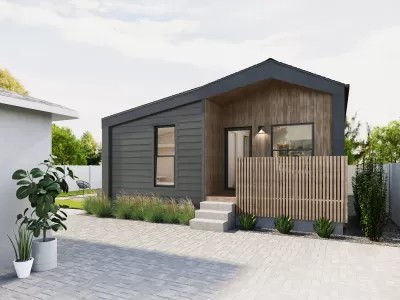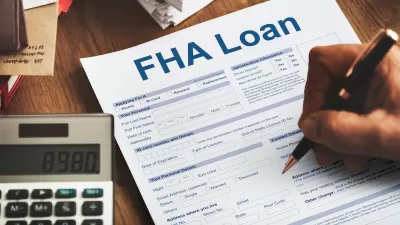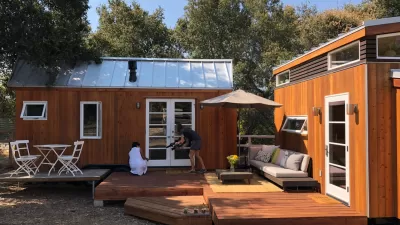How can we get more accessory dwelling units built, keep them affordable, and make them a force for increasing racial equity?

Accessory dwelling units, or ADUs, have become one piece of an answer to building a housing system that has enough housing, at the right cost, for everyone. Because they tend to be smaller, ADUs are theoretically more affordable. These smaller units can be added to current single-family homes—in backyards, basements, or over garages—and they don’t add to sprawl. They bring rental options to places that lack them, and can give homeowners a little additional cash flow.
But as Shelterforce explored last year in the Under the Lens series ADUs Explained, it’s not quite as simple to implement as it sounds.
Shelterforce’s Miriam Axel-Lute recently moderated a conversation about accessory dwelling units during Next City’s Solutions of the Year convening.
Miriam Axel-Lute: There are three separate questions when it comes to ADUs, affordability, and equity. First, how to get them built in any quantity. But then there are two other intertwining questions that are of central importance. One, how to make building an ADU feasible for and accessible to the lower-income homeowners who could use the cash flow the most and to the homeowners of color who’ve been excluded from building the kind of equity in their homes that would make financing an ADU easier, and also how to create ADU units that are themselves accessible and affordable to the lower-income renters. Our speakers today are working on these questions, but especially those last two, coming at it from different angles in different parts of the country.
I’m going to start off our discussion by turning things over to Nikki Beasley and Domanic Green, who work with the Keys to Equity program in California.
Nikki Beasley: We have been on the mark of creating innovation, as it relates to figuring this thing out, and it’s good to know we are not alone. We sit in the city of Richmond, California, supporting Alameda, Contra Costa, and Solano counties.
The Keys to Equity program is specific to the city of Oakland homeowners, with a guided principle of helping the Black homeowner. It is not an exclusive program, but some of the data shows that the Black homeowner definitely deserves the opportunity to have some focus. Since 2011, rent in the city has increased over 72 percent. Eighty percent of Oakland’s lowest-income households are cost burdened as relates to the amount of their income going to their rental housing, and as many Bay Area cities have acknowledged, there’s been an exodus of the African American community in the city of Oakland, and in the Bay Area. Oakland at one time had the highest concentration of Blacks, but it is now transitioned.
Because of that, we wanted to think through our approach. This whole program was started early 2020. The city of Oakland reached out to the Chan Zuckerberg [Initiative] and said, “Hey, we have an idea. What if we try to bring accessory dwelling units to the homeowners with the explicit purpose of focus on the Black homeowner?”
Through that process an RFP was created. Richmond Neighborhood Housing Services, along with other community partners, came up with an idea. It was selected, and then in 2021, we worked on the execution, and this program officially launched in October 2021. And the strategic approach is continuing to work with public private partnerships because it is very clear that there are many moving parts to the work. So it’s imperative that we have ...
Please see the source article to continue reading.
FULL STORY: Taking the ADU Model to the Next Level, a Shelterforce and Next City Webinar

Planetizen Federal Action Tracker
A weekly monitor of how Trump’s orders and actions are impacting planners and planning in America.

Restaurant Patios Were a Pandemic Win — Why Were They so Hard to Keep?
Social distancing requirements and changes in travel patterns prompted cities to pilot new uses for street and sidewalk space. Then it got complicated.

Map: Where Senate Republicans Want to Sell Your Public Lands
For public land advocates, the Senate Republicans’ proposal to sell millions of acres of public land in the West is “the biggest fight of their careers.”

Maui's Vacation Rental Debate Turns Ugly
Verbal attacks, misinformation campaigns and fistfights plague a high-stakes debate to convert thousands of vacation rentals into long-term housing.

San Francisco Suspends Traffic Calming Amidst Record Deaths
Citing “a challenging fiscal landscape,” the city will cease the program on the heels of 42 traffic deaths, including 24 pedestrians.

California Homeless Arrests, Citations Spike After Ruling
An investigation reveals that anti-homeless actions increased up to 500% after Grants Pass v. Johnson — even in cities claiming no policy change.
Urban Design for Planners 1: Software Tools
This six-course series explores essential urban design concepts using open source software and equips planners with the tools they need to participate fully in the urban design process.
Planning for Universal Design
Learn the tools for implementing Universal Design in planning regulations.
Heyer Gruel & Associates PA
JM Goldson LLC
Custer County Colorado
City of Camden Redevelopment Agency
City of Astoria
Transportation Research & Education Center (TREC) at Portland State University
Camden Redevelopment Agency
City of Claremont
Municipality of Princeton (NJ)





























